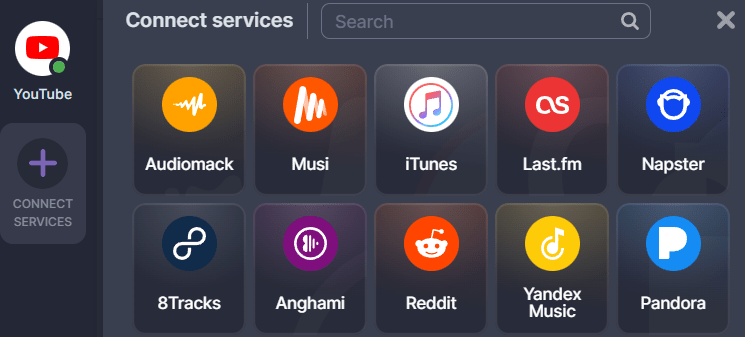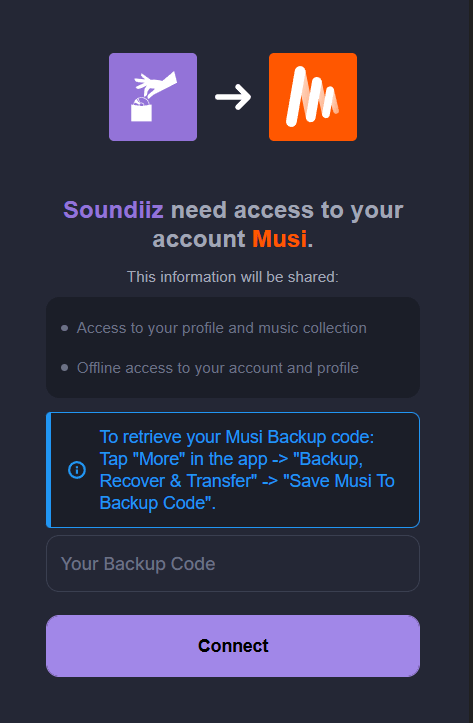It’s been rumored for months, but it’s now true: Musi, a streaming service designed to make music freely available, has suffered its first real setback. No longer available for download on the App Store, the application may well be on its way out. In the process, many of its users have been left destitute. Will millions of people lose their likes and playlists for good? Not with Soundiiz! How to recover all of your Musi data?

With Soundiiz, it’s easy, and we’ll explain everything!
What is Musi?
Launched in 2013 by two teenagers, Musi soon attracted millions of users. The reason is simple: the service is 100% free. Particularly popular in the United States, Musi has established itself as the preferred solution for students and a young audience who cannot afford a monthly subscription to Spotify, Apple Music, YouTube Music, or any other streaming platform. And it doesn’t matter if its ergonomics leave something to be desired or if its functionalities are limited compared to the competition. Musi stands out with something the others don’t have and never will: they offer free access to music without the user having to pay a cent.

In 2016, one of the co-founders, Christian Lunny, explained:
“What if we took the way you organize music on your phone, put that into an app, and tied that in with YouTube, where artists put up their music accessible to stream?”
A grey area
At first glance, the method is dubious, even illegal. However, by exploiting the loopholes in a legal system that struggles to protect rights holders fully, Musi has attracted millions of users and became the tenth most-used music streaming platform in the United States. Their strategy is simple: Musi takes the music catalog of YouTube and Soundcloud and makes it available to its users without integrating the video dimension. Their line of defense is based on the fact that they do not store any data extracted from YouTube. Once the songs have been retrieved, Musi distributes them on its interface.

In a 100% free version, users can listen to the entire YouTube and Soundcloud catalog in return for watching an ad when the application opens. Alternatively, the ads can be removed for less than $6 a month—half the price of a monthly subscription to most music streaming platforms.
Why did Musi close?
As you’d expect, an application that draws its content from YouTube without worrying about copyright issues attracts suspicion. As soon as it was launched, there were calls, particularly from YouTube, for the service to be shut down. But Musi prospers by playing with legislation in a gray area that complicates legal action.
In early 2024, spokeswoman Evelyn Swiderski from Vevo told Wired:
“We have recently been made aware of the music video app Musi. Vevo has not licensed music videos on the app, and Musi is using the Vevo mark on its service without a license. Vevo will take appropriate measures.”

The first step towards closure was in July 2024, when media outlets reported that the International Federation of the Phonographic Industry had pressured Musi and its partners. In particular, it denounced Musi’s availability on the App Store and encouraged industry leaders to take their grievances to YouTube Music as well. This is nothing new: Musi has been under pressure from legal bodies since its launch. But then things accelerated a few weeks after July 2024.
Concrete measures
On September 25, 2024, although Apple had previously refused to remove the application from its App Store, which had generated hundreds of thousands of downloads, the application disappeared from the App Store. This decision follows further pressure from YouTube and the National Music Publishers Association. In an Instagram post, Musi explains itself and tries to reassure its users:
“The app is currently unavailable while we address some comments relating to the App Store. We don’t have an estimated time when it’ll be back, but rest assured, this has our top attention!”
Words that try to cover the fire, but that shouldn’t prevent Musi from gradually if not totally, disappearing from the music landscape. Musi executives have initiated legal proceedings to sue Apple. As reported by Digital Music News, Musi “claims that it does not violate YouTube’s terms of service because it does not utilize the API provided by YouTube to developers. Instead, developers claim they designed their own “augmentative interface” to deliver publicly available content from YouTube”

YouTube naturally believes the opposite, and Musi accuses Apple of making a pact with Google’s platform. The legal battle looks set to continue! While we await the trial’s outcome, many Musi clones are beginning to emerge. Based on the same model, they hope to exploit the void left by Musi. Time will tell whether they will reach Musi’s level of popularity, but it seems highly unlikely.
But then, how to recover your Musi data, if you were a Musi user?
How to recover all of your Musi data with Soundiiz?
As you know, Soundiiz not only tries to stay ahead of trends in the music industry but also tries to be as responsive as possible to changes in the streaming world. Once Musi was removed from the App Store, we set to work to provide a solution for the millions of people who were left without their music catalog and playlists.
We made Soundiiz compatible with Musi, which was not the case before. As a result, you can retrieve all your Musi data and add it to your Soundiiz account. The only prerequisite is that you still have your Musi application installed and have yet to delete it—otherwise, you won’t be able to follow the procedure below, as Musi is no longer downloadable.
In your Musi application, you’ll need to retrieve your “Backup Code,” available in the “More” section of the app. Then click on “Backup and Transfer,” then “View previous backup codes” and “Copy.”
You now possess a code enabling you to associate it with Soundiiz. You now need to connect to your Soundiiz account.

On the home page, click on the purple “Connect Services” cross, then search for “Musi” in the list of available platforms. A window will open, asking you to copy your “Backup Code.” Copy it and let Soundiiz do the work!

All your Musi data, playlists, and favorites are now associated with Soundiiz! You can now process them with Soundiiz tools to optimize their use and do whatever you want with them. Export them as a text or CSV file, or export them to another music platform! The possibilities are endless.
What can you do with your Musi data after you recover it?
Thanks to the abovementioned procedure, your Musi data is now available on Soundiiz. This means you can manipulate it to your heart’s content, thanks to the tools we’ve developed for years. For example, you can create back-ups of your playlists and favorite tracks by downloading them in txt. or CSV format. This will enable you to store them somewhere and retrieve them intact. You can also share them with friends and family or use them for other purposes.

Most interesting, you can transfer your Musi data to another music streaming platform. As Musi looks set to close its doors, you must find a fallback solution. Thanks to our Transfer function, you can switch from Musi to Spotify, Apple Music, Amazon Music, YouTube Music, or TIDAL in seconds. Not only will your data be preserved, but it will also be playable elsewhere. You can also modify all your Musi data directly on your Soundiiz home page: if you import your data to another platform, these modifications will be considered. Practical, isn’t it?

In a way, our services extend the use of Musi, but this time, within a legal framework in which artists and labels are remunerated. As with all other streaming platforms, Soundiiz is the ideal companion for making the most of your music data, securing it, sharing it, and developing it as you wish.
To test our services and recover your Musi data, click here!



